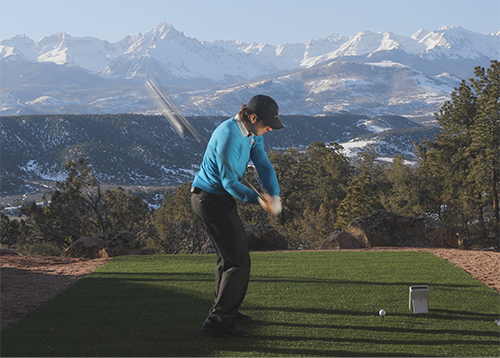Bernhard Langer vs. Camilo Villegas
Bernhard Langer vs. Camilo Villegas
Description
Bernhard Langer is nearly 58 years old and still averages almost 280 yards off the tee. In this video, I'll show you how to prioritize the 3 key components for clubhead speed so that you can hit longer shots no matter how old you are.
Video Practice Points
- Stay wide as long as you can during the takeaway and backswing
- Make rotation your first priority in the swing unless you have limited range of motion
- Rotation, width and leverage are the key components to speed in your golf wing

This week I'm going to showing you three critical moves that Bernhard Langer does in his golf swing. I'm also going to be comparing him to the 32 year old, Camilo Villegas. You don't want to miss this. Let's go ahead and get started.
It's pretty safe to say that all of us have said it at one point or another in our golfing career that we want to be able to hit it further. We want more consistency and we want to hit it further. This week, we're going to focus in on three critical areas of the golf swing that are going to help you understand. No matter what age group you're in, if you prioritize things in a way, you can still maximize efficiency for a long time and you can still hit it just as far as Bernhard does at 57, almost 58 years old, hitting it 280 yards on average.
Let's go ahead and take a look here. I've got the young bucks on the right, so I've got Camilo on the right and I've got the old timers on the left hand side. I'm going to draw a couple of key lines for us as we start to move through the review so you can really understand how each player works the entire body throughout the process here to maintain efficiency based off of what they have to offer in the golf swing. Bernhard Langer is one of those players that takes his fitness extremely serious. He is working out all the time, he has always been one of those players that spends a lot of time on his fitness. He's been able to maintain the three ingredients that really help him with efficiency.
Let's go ahead and take a look here into the takeaway. I've drawn the tush line here and I've drawn a right knee line. I'm going to go ahead and look at both players here into the takeaway. You're going to see that they've got their hands out in front of their chest. You can see that the center of the chest on both players is right in line with the hands, and that the right arms is nice and straight. You see how the right arm is nice and straight here? Both players have rotated about 45 degrees. That's talking about the first two ingredients to efficiency. That's rotation and that's width. We call the right arm the governor of width. We want to be able to stay as wide as possible going back with the golf club no matter what age group you're in.
If you're starting to get up there in the years and you're not able to rotate, or you're losing some of your range of motion, one of the ways to make up for that is to make sure that you've got a ton of width. We have a great video on the website called The Straight Right Arm to Turn video. That is a phenomenal video that's going to teach you how to prioritize things in a way, it's going to help you rotate, but it's also going to give you a lot of width in your golf swing. Definitely check that video out no matter what age group you're in.
All right, so let's go ahead and take a look up here as we work up into the top part of the golf swing. I want you to notice both players here at the top part of their golf swing, you can see that they've still maintained a lot of width. Their right arm has got a little bit of flex in it, probably about 80 to 90 degrees for both players. The left arms is extremely straight at the top of the swing and both hands are extended away from the shoulder in the right ear. That's imperative for width. You want to make sure, again, that you have no flexing in that left arm. If you tend to have a lot of break down in the left arm, you might want to look to see if you've got too much right arm flexion. You want to get kind of that sweet spot to where you can still keep the hands as extended away from the right shoulder, the right ear, as possible at the top part of the swing.
Let's just focus on the young bucks on the way down here. We're going to focus on a critical move that helps with a third component of efficiency, and that's going to be leverage. Leverage can be established through lag and release. It can also be leveraged through, or you can build leverage by pulling power out of the group using the lower body to move power up the kinetic chain. You're going to see a very common thing with younger players is they're going to make more of a squat move. You can see here he starts to squat down and he gets really over into that left side. Now, he's really pulling the power out of the ground.
One of the things that we would not condone at Rotary Swing is this right foot way off the ground as the hands get down to the hitting area. That right foot is a trail side push. A lot of players that try to do this squat move, or haven't really kind of perfected the idea of how they're going to control from the lead side of the body, you'll see that this right knee would break through that line. If you were watching your golf swing, you would see that your right knee would be way through this line and you would also notice that your hips would be coming forward to where you would be coming off the tush line. Those two things can really start to slow the club down and it can create a mess for consistency. If you're one of those squatters out there, one of those young bucks that's really trying to leverage the ground, make sure that you understand how to look at your golf swing, how to evaluate things, and make sure that if you're going to use the trail side to push the hips or help the hips, that you can still control things from the left side of the body. That's critical no matter what age group that you're in. You still want to be able to control the hip so you don't want to turn into a hip spinner. Trust me, that's big issue.
You're going to see over here with Bernhard, he's going to use not nearly as much squat. Let me go ahead and move these lines off the screen. You're going to see that he doesn't make any sort of drastic squatting move. What he's doing at this particular point of the golf swing, is you can see that this left knee had a lot of bend to it. Now, as he's working down in the hitting area, if I had a face on perspective, you could see that his left leg has gone into a very straight position. His left leg, right there, and now it's stalling the hips, and now he's released the golf club, and you can see that he had a good amount of lag as the hands were approaching in front of the right thigh, and that he's pulling that left leg to a straight position. We have that video on the website, the Straight Left Leg and Impact video, that's another good video that's going to help you understand how the lower body works in the downward move.
You can see just a little bit of push from the trail side here, off of Bernhard, where he's got his right knee poking through there. He's done a fairly good job of keeping the hips back, but you can see with this movement of the hips forward, his spine angle has actually straightened. Now, that's where I get back into the rotational aspect. Because of the fact that Bernhard has got himself into a little bit older of an era here, that's out of respect for you old timers, you can notice here that he's got a lot less side bend than Camilo does. You can see Camilo's got a lot of side bend here where it's going to put a lot of compression on the spine.
Now, as a safety move here for Bernhard, he's allowed his spine to go more vertical in the hitting area because of the fact that that's not going to put a lot of compression on the back. That's a good way for you to understand that. He's taken a little bit of the rotation aspect out of there, he's not really try to jam down through the hitting area, he's stalled the lower body properly, and he's releasing it through lag and release. He's got great action through the hands to the hitting area.
Again, the whole point of today was to talk to guys about how to prioritize things no matter what age group you're in. If you're getting up there in years and you feel like your range of motion's really shutting down and you really want to protect and preserve the body, which is super important to all of us at Rotary Swing, is make sure you understand how to prioritize things with leverage and rotation. Make sure you understand how important those are to you, put those to use, get out there and play some great golf. I do want to give you guys a heads up this week is we've got a great video that's geared towards old timers that are really trying to maximize a lot of speed in their game. Chuck, our founder at Rotary Swing, has put this great video together with some great drills in it. You definitely want to check that video out and get out there and bomb it. Keep bombing it no matter what age you are and play some great golf. I look forward to working more with you in the future and I hope you have a great day.
If you've been spending a lot of your time lately telling yourself that you're getting much too old to still bomb the golf ball, then you want to pay close attention to this week's breakdown of Bernhard Langer's golf swing. This guy's 57 years old and is still pounding the golf ball nearly 280 yards on average. Hi, guys. I'm rotary swing instructor, Chris Tyler. This week I'm going to showing you three critical moves that Bernhard Langer does in his golf swing. I'm also going to be comparing him to the 32 year old, Camilo Villegas. You don't want to miss this. Let's go ahead and get started.
It's pretty safe to say that all of us have said it at one point or another in our golfing career that we want to be able to hit it further. We want more consistency and we want to hit it further. This week, we're going to focus in on three critical areas of the golf swing that are going to help you understand. No matter what age group you're in, if you prioritize things in a way, you can still maximize efficiency for a long time and you can still hit it just as far as Bernhard does at 57, almost 58 years old, hitting it 280 yards on average.
Let's go ahead and take a look here. I've got the young bucks on the right, so I've got Camilo on the right and I've got the old timers on the left hand side. I'm going to draw a couple of key lines for us as we start to move through the review so you can really understand how each player works the entire body throughout the process here to maintain efficiency based off of what they have to offer in the golf swing. Bernhard Langer is one of those players that takes his fitness extremely serious. He is working out all the time, he has always been one of those players that spends a lot of time on his fitness. He's been able to maintain the three ingredients that really help him with efficiency.
Let's go ahead and take a look here into the takeaway. I've drawn the tush line here and I've drawn a right knee line. I'm going to go ahead and look at both players here into the takeaway. You're going to see that they've got their hands out in front of their chest. You can see that the center of the chest on both players is right in line with the hands, and that the right arms is nice and straight. You see how the right arm is nice and straight here? Both players have rotated about 45 degrees. That's talking about the first two ingredients to efficiency. That's rotation and that's width. We call the right arm the governor of width. We want to be able to stay as wide as possible going back with the golf club no matter what age group you're in.
If you're starting to get up there in the years and you're not able to rotate, or you're losing some of your range of motion, one of the ways to make up for that is to make sure that you've got a ton of width. We have a great video on the website called The Straight Right Arm to Turn video. That is a phenomenal video that's going to teach you how to prioritize things in a way, it's going to help you rotate, but it's also going to give you a lot of width in your golf swing. Definitely check that video out no matter what age group you're in.
All right, so let's go ahead and take a look up here as we work up into the top part of the golf swing. I want you to notice both players here at the top part of their golf swing, you can see that they've still maintained a lot of width. Their right arm has got a little bit of flex in it, probably about 80 to 90 degrees for both players. The left arms is extremely straight at the top of the swing and both hands are extended away from the shoulder in the right ear. That's imperative for width. You want to make sure, again, that you have no flexing in that left arm. If you tend to have a lot of break down in the left arm, you might want to look to see if you've got too much right arm flexion. You want to get kind of that sweet spot to where you can still keep the hands as extended away from the right shoulder, the right ear, as possible at the top part of the swing.
Let's just focus on the young bucks on the way down here. We're going to focus on a critical move that helps with a third component of efficiency, and that's going to be leverage. Leverage can be established through lag and release. It can also be leveraged through, or you can build leverage by pulling power out of the group using the lower body to move power up the kinetic chain. You're going to see a very common thing with younger players is they're going to make more of a squat move. You can see here he starts to squat down and he gets really over into that left side. Now, he's really pulling the power out of the ground.
One of the things that we would not condone at Rotary Swing is this right foot way off the ground as the hands get down to the hitting area. That right foot is a trail side push. A lot of players that try to do this squat move, or haven't really kind of perfected the idea of how they're going to control from the lead side of the body, you'll see that this right knee would break through that line. If you were watching your golf swing, you would see that your right knee would be way through this line and you would also notice that your hips would be coming forward to where you would be coming off the tush line. Those two things can really start to slow the club down and it can create a mess for consistency. If you're one of those squatters out there, one of those young bucks that's really trying to leverage the ground, make sure that you understand how to look at your golf swing, how to evaluate things, and make sure that if you're going to use the trail side to push the hips or help the hips, that you can still control things from the left side of the body. That's critical no matter what age group that you're in. You still want to be able to control the hip so you don't want to turn into a hip spinner. Trust me, that's big issue.
You're going to see over here with Bernhard, he's going to use not nearly as much squat. Let me go ahead and move these lines off the screen. You're going to see that he doesn't make any sort of drastic squatting move. What he's doing at this particular point of the golf swing, is you can see that this left knee had a lot of bend to it. Now, as he's working down in the hitting area, if I had a face on perspective, you could see that his left leg has gone into a very straight position. His left leg, right there, and now it's stalling the hips, and now he's released the golf club, and you can see that he had a good amount of lag as the hands were approaching in front of the right thigh, and that he's pulling that left leg to a straight position. We have that video on the website, the Straight Left Leg and Impact video, that's another good video that's going to help you understand how the lower body works in the downward move.
You can see just a little bit of push from the trail side here, off of Bernhard, where he's got his right knee poking through there. He's done a fairly good job of keeping the hips back, but you can see with this movement of the hips forward, his spine angle has actually straightened. Now, that's where I get back into the rotational aspect. Because of the fact that Bernhard has got himself into a little bit older of an era here, that's out of respect for you old timers, you can notice here that he's got a lot less side bend than Camilo does. You can see Camilo's got a lot of side bend here where it's going to put a lot of compression on the spine.
Now, as a safety move here for Bernhard, he's allowed his spine to go more vertical in the hitting area because of the fact that that's not going to put a lot of compression on the back. That's a good way for you to understand that. He's taken a little bit of the rotation aspect out of there, he's not really try to jam down through the hitting area, he's stalled the lower body properly, and he's releasing it through lag and release. He's got great action through the hands to the hitting area.
Again, the whole point of today was to talk to guys about how to prioritize things no matter what age group you're in. If you're getting up there in years and you feel like your range of motion's really shutting down and you really want to protect and preserve the body, which is super important to all of us at Rotary Swing, is make sure you understand how to prioritize things with leverage and rotation. Make sure you understand how important those are to you, put those to use, get out there and play some great golf. I do want to give you guys a heads up this week is we've got a great video that's geared towards old timers that are really trying to maximize a lot of speed in their game. Chuck, our founder at Rotary Swing, has put this great video together with some great drills in it. You definitely want to check that video out and get out there and bomb it. Keep bombing it no matter what age you are and play some great golf. I look forward to working more with you in the future and I hope you have a great day.
Testimonials

-Dr. Jeffrey Broker, Assoc. Prof. in Biomechanics at University of Colorado at Colorado Springs and Former Senior Biomechanist for U.S. Olympics Committee

-Hub Orr - Happy PREMIUM MEMBER of RotarySwing.com

-Sam Jarman, PGA Golf Instructor in the UK

Build the perfect golf swing following the most advanced online golf swing learning system!
JOIN OUR 445,148 MEMBERS AND GET INSTANT FREE ACCESS TO DOZENS OF VIDEOS!



